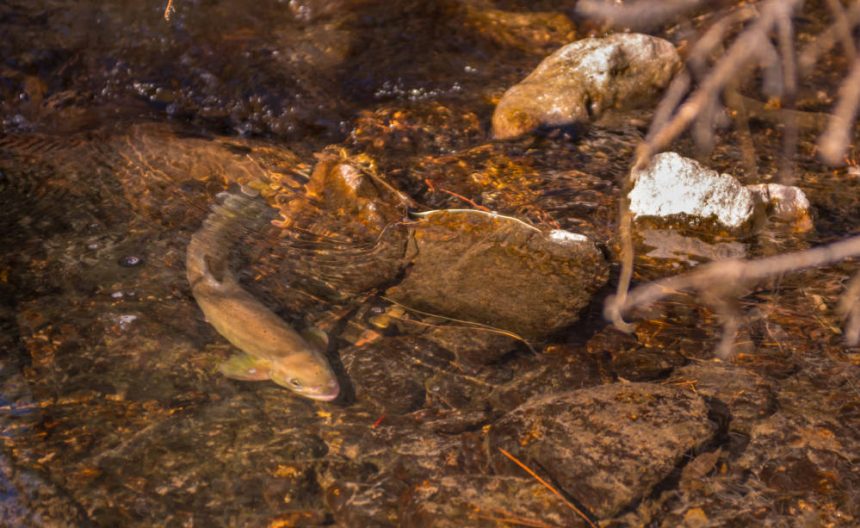This article originally appeared in the Fishing Wire on Jan 29, 2024
By Craig Springer, USFWS
James Ohio Pattie by our best reckoning was the first to record catching Gila trout. The man led a beaver trapping expedition from Kentucky that traversed today’s American Southwest shortly after Mexico achieved its independence from Spain.
Pattie and his cohorts trapped the Gila River headwaters in southwest New Mexico. He wrote of his 1824 experience at the confluence of the West and Middle forks of the Gila River.

“On the morning of 13th [December] we started early, and crossed the river Helay, here a beautiful clear stream about thirty yards in width, running over a rocky bottom and filled with fish. We found here a boiling spring so near the main stream, that the fish caught in one might be thrown into the other without leaving the spot where it was taken. In six minutes, it would be thoroughly cooked.”
Two hundred years later, the hot spring still sends steam pluming into the air on cold winter mornings. Gila trout though are long gone, the reasons for which have affected native trout throughout the West. The causes have become platitudes worn smooth like creek stones; they have unfortunately been told so much.
Overstocking and excessive grazing of cattle and sheep degraded Gila trout habitat by taking away cooling shade of streamside willows and alders, the roots of which stitched banks in place and captured sediments before spilling into streams that now clog spawning gravels. The spaces between stones within the streambed jammed with sediment afford fewer places for aquatic insects—trout food—to flourish.
Non-native trout species bred with and outcompeted Gila trout for food to eat and spaces to hide. Consider that brown trout spawn in autumn, their eggs hatch in late winter or early spring, at which time Gila trout are just then thinking about building redds and spawning. When Gila trout fry leave the gravels in June, brown trout young-of-the-year are already fingerling-sized trout—and what do they eat? Their penchant for piscivory starting at an early age is legendary. Gila trout suffered for it.

Having retreated to a handful of isolated headwater streams in the Gila National Forest, Gila trout waters were closed to fishing in 1966. In in 1973, the colorful copper and yellow trout was listed as endangered and remained so until 2006. Conservation endeavors underway by the New Mexico Department of Game and Fish (NMDGF) proved fruitful, funded by excise taxes paid by fishing tackle manufacturers and a motorboat fuel tax via the Dingell-Johnson Act (Sport Fish Restoration), as well as congressionally appropriated State Wildlife Grants.
Reliable and consistent funding paid for conservation barriers placed at the downstream terminuses of Gila trout habitat prevented future invasions of non-native fishes. Stream-to-stream transfers expanded the trout’s range. Brood stocks developed at Mora National Fish Hatchery in cooperation with the NMDGF are managed at the genetic level to ensure purity and fitness for the several lineages of Gila trout identified by geneticists. The NMDGF’s Glenwood Fish Hatchery, built during the Great Depression and tooled today in modernity, figures prominent in the propagation and conservation of Gila trout. Fishing license sales and Sport Fish Restoration dollars support the hatchery that lies along nearby Whitewater Creek.

Gila trout in Whitewater Creek is among the most notable conservation successes. This is paradoxical on its face, but the Whitewater-Baldy Fire in 2012, devastating and massive in size, created a conservation opportunity. The fire and subsequent summer monsoon rains delivered slugs of slurry comprised of ash and mud. The flow rid the large watershed of non-native competing fish, and in went Gila trout. It now affords a tremendous fishery and an attraction for anglers.

After a 50-year hiatus and much sweat equity, select waters in the Gila National Forest were open to angling. One can now lay a bow cast down in isolated dendritic blue veins in the recesses of narrow canyons where Gila trout hold their own.

